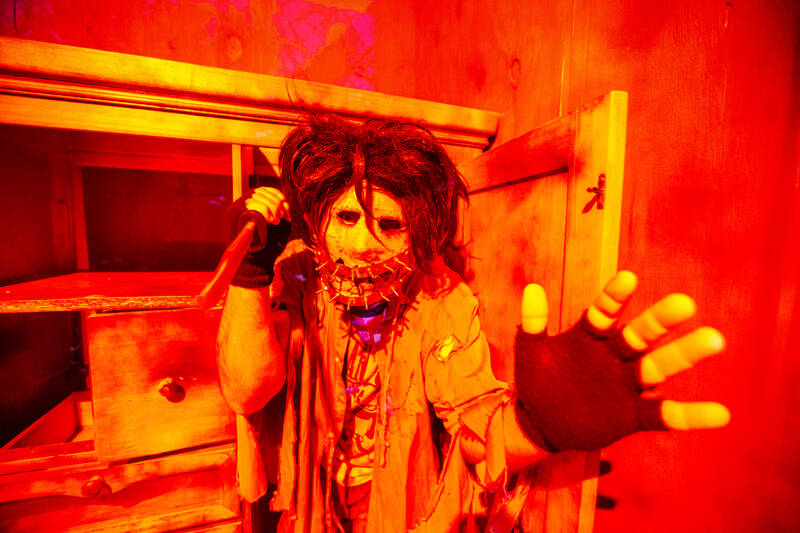Palms sweat, heartbeat quickens, muscles tense. Your skin prickles and stomach churns. When fear subsides, we can be left with feelings of pleasure. Is this just the relief of having survived, or is it something more?
FIGHT OR FLIGHT
The amygdala, an almond-shaped bundle of neurons deep in the center of the brain, controls the fear response. In a fearful situation, the amygdala stimulates the hypothalamus, which activates two systems in the body — the sympathetic nervous system and the adrenal cortical system — causing a flash flood of hormones and triggering the fight-or-flight response.

Photo: EPA-EFE
Adrenaline boosts the body’s alertness. It speeds up the heart rate and diverts blood from the core to the muscles needed for movement. Cortisol raises blood pressure. Blood vessels around the vital organs dilate, flooding them with oxygen and nutrients. Breathing quickens, delivering fresh oxygen to the brain, while levels of glucose in the blood spike, giving the body a quick energy boost — ready for action.
“Although we have an understanding of some aspects of neural fear networks and how they coordinate behavior, there are still many unknowns,” says Charlotte Lawrenson, a neuroscientist at Bristol University.
In early societies, fear-inducing tales were used to teach children about dangers they might encounter

Photo: AP
When we are exposed to sensory stimuli or an environment that is potentially threatening, she says, two pathways are activated in the brain. The first is fast. Information is transferred to the sensory thalamus and then to the amygdala, allowing for immediate action on the threatening stimuli.
The second is a slower, indirect route. Information is sent from the thalamus to the cortex, the outermost layer of the brain, associated with consciousness, reasoning and memory. This analysis the threat and allows us to determine whether we are in real danger.
“We do not know exactly where the feeling of fear occurs in the brain,” says Lawrenson, “but it is likely to be from the coordinated activation of a fear network involving multiple brain regions.”
If the threat is determined to be real, other areas of the brain will be activated to initiate a whole-body response to the danger. This includes the periaqueductal grey, which coordinates the antinociceptive, autonomic and behavioural reactions to stress and injury, blocking the detection of pain by sensory neurons and kickstarting the involuntary physiological processes and responding action.
“The memory of [the danger] will be transferred and stored in the hippocampus,” adds Lawrenson’s co-researcher, Elena Paci, “so that we are able to remember and identify the threat at the next encounter.”
WINDOW ON COLLECTIVE FEARS
Fear is an ancient emotion and scary stories are ingrained in human history. In early societies, fear-inducing tales were used to teach children about dangers they might encounter, such as wolves and other predators. Today, cinema offers a window into society’s collective fears. In the 1954 sci-fi film, Godzilla was created by nuclear radiation, revealing the shared anxiety about the second world war atomic attacks.
Horror films have often featured technology — robots that revolt against their creator like the Westworld hosts, or murderous AI such as Hal in 2001: A Space Odyssey and Skynet in The Terminator. In the late 1970s and the 1980s, Michael Myers and Freddy Krueger made their appearances alongside the emergence of the serial killer in the public consciousness.
In March 2020, when the pandemic went into hyperdrive, downloads of the movie Contagion — about a deadly pandemic — surged. Why did people want to watch a horror film about something so real to them at that point in time? Prof Marc Malmdorf-Andersen and his colleagues think that horror films have learning potential for uncertainty management.
NAVIGATING AN UNPREDICTABLE WORLD
An associate professor at Denmark’s Aarhus University, Malmdorf-Andersen researches the cognitive processes involved in play and learning.
“Spending time in these fictional realms can almost be thought of as an opportunity to draft up your own instruction book for worst-case scenarios,” he says.
A study on horror fans during the COVID pandemic found that people who enjoyed watching scary films were more psychologically resilient than non-horror fans.
“They have, in some ways, been exposed to similar scenarios and might use that experience for navigating new, uncertain realities,” says Malmdorf-Andersen. “It is possible that recreational forms of fear in general can help improve emotion regulation and coping skills.”
Enjoyment of fear, says Malmdorf-Andersen, makes sense if you look at it as a “form of play.” “Enjoyment of scary stimuli seems to be related to getting a grip on unpredictable situations,” he says. “In much the same way, children’s play is characterized by seeking out moderate amounts of uncertainty, moderate surprises, in an effort to make sense of them.”
In fact, researchers at Exeter University say that when children’s play involves risk and fear, it can function as a protective factor against anxiety. Play, says Malmdorf-Andersen, is a strategy for learning how to deal with unfamiliar situations and making the unpredictable predictable.
SWEET SPOT
To investigate the relationship between enjoyment and fear, Malmdorf-Andersen and his colleagues at Aarhus University’s Recreational Fear Lab studied a group of people who went to a haunted house visitor attraction. There, the guests voluntarily signed up to be terrified by brain-munching zombies, chainsaw-wielding maniacs and child-eating murderers. The researchers filmed the guests, monitored their heart rates and asked them how they felt at various points during the experience.
“At Dystopia Haunted House there are about 70-100 scare actors each night,” says Malmdorf-Andersen, “and a large special-effects department. They challenge their guests on a lot of different levels — disgust, fear, jump scare, unease, being alone, being in the dark, claustrophobia…”
The findings indicated that humans don’t enjoy being too far from their normal physiological state, but they do enjoy being just a little bit out of their comfort zone.
“Our results suggest that there might be a ‘sweet spot’ between fear and enjoyment,” says Malmdorf-Andersen. “A just-right spot where the context is not too terrifying, but not too tame either. This sweet spot seems to be where enjoyment is maximized.”
At that spot, a flood of fear quickly followed by relief results in the release of feelgood chemicals in the brain — endorphins and dopamine — rewarding you with a rush of euphoria.
However, it is important to keep in mind that everyone is different. We all have a unique sense of what we find scary — and it’s a fine line between harmless fun and genuine terror. Too much fear can lead to distress and dysfunction. Globally, about 275 million people suffer from anxiety disorders, which can become chronic and debilitating and affect a person’s life trajectory.
“Different people have a different level of activation of certain areas [of the brain],” says Paci.
What can be a thrill for one person can be truly terrifying for another. So dare to be scared this Halloween — but just the right amount.

US President Donald Trump may have hoped for an impromptu talk with his old friend Kim Jong-un during a recent trip to Asia, but analysts say the increasingly emboldened North Korean despot had few good reasons to join the photo-op. Trump sent repeated overtures to Kim during his barnstorming tour of Asia, saying he was “100 percent” open to a meeting and even bucking decades of US policy by conceding that North Korea was “sort of a nuclear power.” But Pyongyang kept mum on the invitation, instead firing off missiles and sending its foreign minister to Russia and Belarus, with whom it

When Taiwan was battered by storms this summer, the only crumb of comfort I could take was knowing that some advice I’d drafted several weeks earlier had been correct. Regarding the Southern Cross-Island Highway (南橫公路), a spectacular high-elevation route connecting Taiwan’s southwest with the country’s southeast, I’d written: “The precarious existence of this road cannot be overstated; those hoping to drive or ride all the way across should have a backup plan.” As this article was going to press, the middle section of the highway, between Meishankou (梅山口) in Kaohsiung and Siangyang (向陽) in Taitung County, was still closed to outsiders

Many people noticed the flood of pro-China propaganda across a number of venues in recent weeks that looks like a coordinated assault on US Taiwan policy. It does look like an effort intended to influence the US before the meeting between US President Donald Trump and Chinese dictator Xi Jinping (習近平) over the weekend. Jennifer Kavanagh’s piece in the New York Times in September appears to be the opening strike of the current campaign. She followed up last week in the Lowy Interpreter, blaming the US for causing the PRC to escalate in the Philippines and Taiwan, saying that as

The Chinese Communist Party (CCP) has a dystopian, radical and dangerous conception of itself. Few are aware of this very fundamental difference between how they view power and how the rest of the world does. Even those of us who have lived in China sometimes fall back into the trap of viewing it through the lens of the power relationships common throughout the rest of the world, instead of understanding the CCP as it conceives of itself. Broadly speaking, the concepts of the people, race, culture, civilization, nation, government and religion are separate, though often overlapping and intertwined. A government